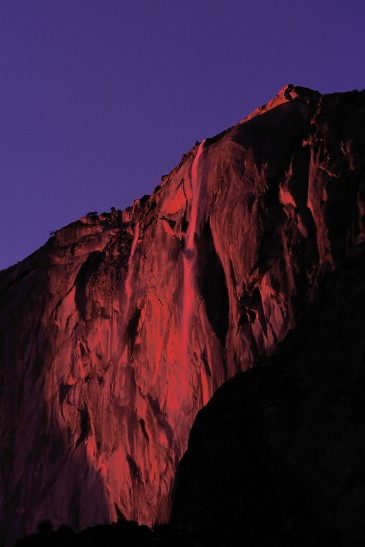Horsetail Fall – The Firefall of Yosemite Park
1:20 AM Places 2 comments Spluch

Horsetail Fall, located in Yosemite National Park in California in 1890. it is world famous for its rugged terrain, waterfall and century-old pine trees. it covers 1200 sq km and the "fire" waterfall of el capitan is one of the most spectacular of all scenery.is a seasonal waterfall that flows in the winter and early spring. The fall occurs on the East side of El Capitan. There are a few days every February where this fall is lit up by the setting sun and reflects a bright orange.
This waterfall descends in two streams side by side, the eastern one being the larger, but both quite small. The eastern one drops 470 m (1,540 ft) and the western one 480 m (1,570 ft), the highest fully-airborne waterfall in Yosemite that runs at some point every year. The waters then gather and descend another 150 m (490 ft) on steep slabs, so the total height of these waterfalls is 650 m (2,130 ft). The image shown here is taken during a brief time during the winter, near 21 February at sunset, made famous by Galen Rowell's photograph.
The fall is best seen and photographed from a small clearing close to the picnic area on the north road leading out of Yosemite Valley east of El Capitan.
the spectacular view of the waterfall is created by the reflection of sunlight hitting the falling water at a specific angle. this rare sight can only be seen at a 2-week period towards the end of feburary. to photograph this rare event, photographers would often have to wait and endure years of patience in order to capture them. the reason is because its appearance depend on a few natural phenomenons occuring at the same time and luck.
1st, is the formation of the waterfall - the water is formed by the melting of snow and ice at the top of the mountain. it melts between the month of december and january and by the end of february there might not have much snow left to melt.
2nd, is the specific angle of the sunray hitting the falling water - the sun's position must be exactly at a particular spot in the sky. this occur only in the month of february and at the short hours of dusk. if it is a day full of clouds or something blocking the sun, you can only take pictures of your own sorry faces on the waterfall. it coincides with the fact that the weather in the national park at that time of the year is often volatile and unpredictable. it compounds to the difficulty of getting these pictures.

















Tags: Places
Sharing is sexyRelated posts
2 comments for this post
Leave a Reply








.jpg)



Not sure where the information came from on the Fire Waterfall of El Capitan, but as one who has actually seen it I can assure you that it is NOT sunlight shining on the waterfall.

I don't know whether they still do it, but the rangers would build bonfire in the evening on the top of El Capitan. Then they would shove the burning bonfire off the top of the mountain and the cascading embers would make the Fire Waterfall shown in the pictures.
If you'll notice in many of the pictures how dark it is in the sky and surroundings you'll realize that the sun was not up at the time for sunlight to hit the waterfall.
You can also see the surrounding rock being "lit" by the light from the embers.
Hope this clears up the information on the background, but nothing can diminish the beauty of the pictures.
I can assure you Hank. It IS sunlight that hits Horsetail falls that illuminates it.
